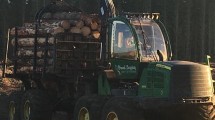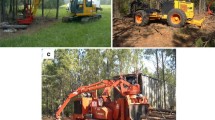Abstract
Two tests were conducted with a new model of mini-forwarder, specifically designed for thinning operations. The tested machine resembles a conventional industrial forwarder, with tandem bogies and central articulation, but is much smaller and lighter. The machine was tested on forest plantations established on ex-farm land: such plantations offer favorable and homogeneous work conditions, which allowed reasonably accurate productivity figures to be obtained with a relatively small number of observation hours (about 10.5 h). Despite the relative inexperience of the driver, the tests indicated a productivity of between 3.1 and 3.8 m3 per scheduled machine hour (SMH) over an extraction distance of about 400 m. Extraction costs ranged from 12.4 to 15.1 € m−3 at the calculated machine rate of 47.6 € h−1. Compared to older models derived from recreation vehicles or tracked wheelbarrows, the machine tested in this study offers a better performance and a much more comfortable workplace, with the operator sitting inside an enclosed and insulated cab. Fitted with four bogies and provided with a much longer wheelbase, the new forwarder is likely to be safer than tracked machines when surmounting obstacles, and it certainly offers a much smoother ride to the operator. Nevertheless, the tested machine is still much narrower than industrial forwarders and does not enjoy the same lateral stability. Hence, the machine is ideal for sneaking between trees and climbing over obstacles, but once on a slope it must be driven straight along the grade and never across it, unless with much caution. Like all hydrostatically driven vehicles, the tested mini-forwarder is not suited to long-distance extraction (>1 km): if run at high speed for too long, its hydrostatic transmission tends to overheat, forcing the operator to make frequent stops.


Similar content being viewed by others
References
Becker P, Jensen J, Meinert D (2006) Conventional and mechanized logging compared for ozark hardwood forest thinning: productivity, economics, and environmental impact. Nort J Appl For 23:264–272
Bergstrand KG (1991) Planning and analysis of forestry operation studies. Skogsarbeten Bull 17:63
Björheden R, Apel K, Shiba M, Thompson MA (1995) IUFRO forest work study nomenclature. Swedish University of Agricultural Science, Department of Operational Efficiency, Garpenberg, p 16
Brinker R, Kinard J, Rummer B, Lanford B (2002) Machine rates for selected forest harvesting machines (Circular 295, revised). Alabama Agricultural Experiment Station, Auburn University, Auburn, p 32
De Lasaux M, Hartsough B, Spinelli R, Magagnotti N (2010) Small parcel fuel reduction with a low-investment, high-mobility operation. West J Appl For (in press)
Gullberg T (1995) Evaluating operator-machine interaction in comparative time studies. J For Eng 7:51–61
Gullberg T (1997) A deductive time consumption model for loading shortwood. J For Eng 8:35–44
Hartsough B (2003) Economics of harvesting to maintain high structural diversity and resulting damage to residual trees. West J Appl For 18:133–142
Iwaoka M, Aruga K, Kobayashi H (1997) A line thinning operation with a crawler type harvester and forwarder combination and its impact on the residual stand. Bull Tokyo Univ For 98:151–160
Iwaoka M, Aruga K, Sakurai R, Hyun Cho K, Sakai H, Kobayashi H (1999) Performance of small harvester head in a thinning operation. J For Res 1:95–200
Kärhä K, Rönkkö E, Gumse S (2004) Productivity and cutting costs of thinning harvesters. Int J For Eng 15:43–56
Kittredge D, Mauri M, McGuire E (1996) Decreasing woodlot size and the future of timber sales in Massachussets: when is an operation too small? Nort J Appl For 13:96–101
Kofman P (1995) Siwork 3: user guide. Danish Forest and Landscape Research Institute, Vejle, p 37
Kumakura Y, Tasaka T, Sakai H (1994) The influence of forest machines on soil compaction in logging operation. J Jpn For Soc 9:41–51
Kuuluvainen J, Karppinen H, Ovaskainen V (1996) Landowner objectives and nonindustrial private timber supply. For Sci 42:300–309
Laitila J, Asikainen A, Nuutinen Y (2007) Forwarding of whole trees after manual and mechanized felling bunching in pre-commercial thinnings. Int J For Eng 18:29–39
Lundmark R (2006) Cost structure and competition for forest-based biomass. Scand J For Res 21:271–280
Miyata ES (1980) Determining fixed and operating costs of logging equipment (Gen Tech Rep NC-55). Forest Service North Central Forest Experiment Station, St. Paul, p 14
Nåbo A, Yamada Y (1992) Accident analyses and capability to surmount obstacles of side-loaded mini-forwarders. J Jpn For Soc 74:9–17
Nurminen T, Korpunen H, Uusitalo J (2006) Time consumption analysis of the mechanized cut-to-length harvesting system. Silva Fenn 40:335–363
Park B, Oh J, Aruga K, Nitami T, Kobayashi H (2004) Examination of the index of fatigue for miniforwarder operators. J Jpn For Eng Soc 19:19–26
Rickenbach M, Steele T (2006) Logging firms, nonindustrial private forests, and forest parcelization: evidence of firm specialization and its impact on sustainable timber supply. Can J For Res 36:186–194
SAS Institute Inc. (1999) StatView reference. SAS Publishing, Cary, pp 84–93
Scott A (1973) Work measurement: observed time to standard time. In: Wittering W (ed) Work study in forestry. For Commun Bull 47: 26–39
Shishiuchi M (1993) Optimal skid trail spacing for small vehicles in thinning. Int J For Eng 5:29–32
Spinelli R, Visser R (2008) Analyzing and estimating delays in harvester operations. Int J For Eng 19:35–40
Spinelli R, Owende PMO, Ward SM, Tornero M (2004) Comparison of short-wood forwarding systems used in Iberia. Silva Fenn 38:85–94
TDB Forest Research (2001) The Alstor mini-forwarder (Inform Note ODW 9.06). TDB Forest Research, Ae Village, p 4
TDB Forest Research (2002) The Scorpion 1205 mini-forwarder (Inform Note ODW 9.07). TDB Forest Research, Ae Village, p 4
Väätäinen K, Asikainen A, Sikanen L, Ala-Fossi A (2006a) The cost effect of forest machine relocations on logging costs in Finland. For Stud 45:135–141
Väätäinen K, Ala-Fossi A, Nuutinen Y, Röser D (2006b) The effect of single grip harvester’s log bunching on forwarder efficiency. Baltic For 12:64–69
Yamada Y (1996) A comparison of six parallel levers and two joysticks for the maneuverability of forwarders. J For Res 1:199–203
Acknowledgments
This work was supported by the Regione del Veneto—Direzione Foreste ed Economia Montana. The authors gratefully acknowledge the assistance of the Servizio Forestale di Verona, and especially of Dr. G. Rivaben, A. Campedelli and D. Tancon. Thanks are also due to Hidrocom (Italian dealer for Entracon) who made the machine available for the tests.
Author information
Authors and Affiliations
Corresponding author
About this article
Cite this article
Spinelli, R., Magagnotti, N. Performance and cost of a new mini-forwarder for use in thinning operations. J For Res 15, 358–364 (2010). https://doi.org/10.1007/s10310-010-0193-x
Received:
Accepted:
Published:
Issue Date:
DOI: https://doi.org/10.1007/s10310-010-0193-x




